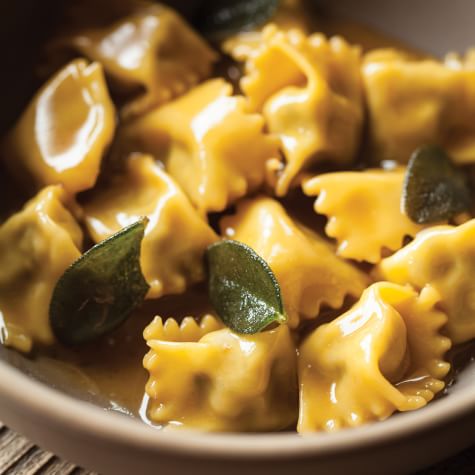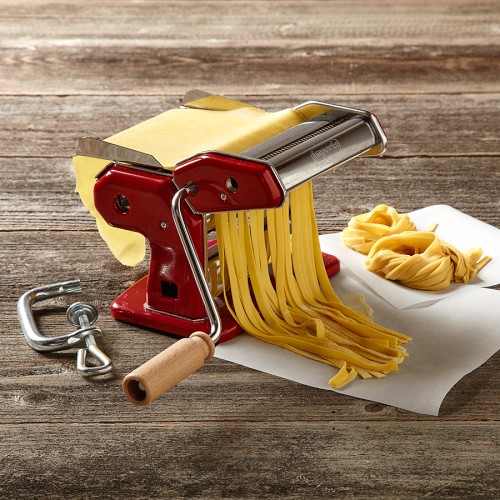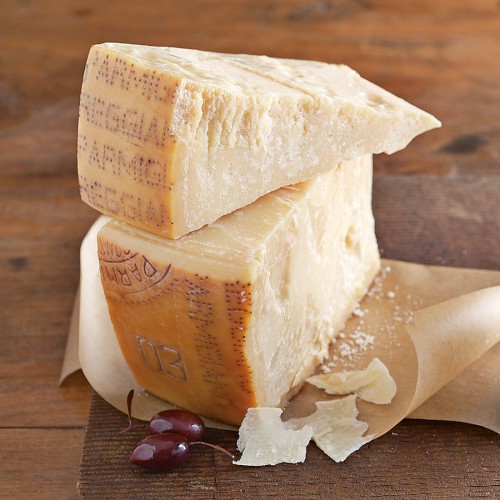
Agnolotti dal Plin
This dish hearkens back to the lavish feasts thrown by Italian dukes once upon a time. During these celebrations, copious amounts of roasted meat were made; the leftover roasted meat was used the next day for agnolotti dal plin. Centuries later, this dish is still a great way to utilize meat trimmings from the previous night’s meal, and Chef Thomas McNaughton explains that this is why this dish is on the menu at his restaurant Flour + Water throughout the year. This recipe uses equal amounts of pork, chicken and rabbit for depth of flavor, but you can tweak the ratios depending on what you have on hand.
Ingredients:
- 1 batch Ravioli Dough
For the filling:
- 3 oz. (90 g) pork shoulder, cut into 1-inch (2.5-cm) cubes
- 3 oz. (90 g) boned chicken thighs, cut into 1-inch (2.5-cm) cubes
- 3 oz. (90 g) rabbit loin, cut into 1-inch (2.5-cm) cubes
- Kosher salt to taste
- 2 Tbs. canola, grapeseed or vegetable oil
- 2 Tbs. olive oil
- 1 small onion, diced
- 1/2 cup (4 oz./125 ml) red wine
- 2 cups (2 oz./60 g) loosely packed spinach, coarsely chopped
- 1/4 tsp. sherry vinegar
- 1 egg
- 3/4 cup (3 oz./90 g) freshly grated Parmigiano-Reggiano cheese
- 1 1/2 tsp. grated nutmeg
- Freshly ground pepper, to taste
To finish:
- Semolina flour for dusting
- 1 cup (8 fl. oz./250 ml) chicken stock
- 8 Tbs. (1 stick) (4 oz./125 g) unsalted butter
- 4 whole sage leaves
- Freshly grated Parmigiano-Reggiano cheese for finishing
Directions:
Prepare the ravioli dough as instructed. Let rest for at least 30 minutes at room temperature. If resting for more than 6 hours, store the dough in the refrigerator. The dough will hold for up 2 days in the refrigerator, but it’s best to use it the same day you make it, because the egg yolks will oxidize and discolor the dough over time. Remove the dough from the refrigerator at least 30 minutes before rolling it out.
To make the filling, in a large bowl stir together the pork, chicken and rabbit and season with a few pinches of salt. Let sit for about 30 minutes. Heat the canola oil in a 12-inch (30-cm) sauté pan over high heat. Once hot, add the seasoned meat and cook, stirring occasionally, until the meat is caramelized and deeply browned, about 5 minutes. Remove the meat to a plate and set aside.
In the same pan over high heat, add the olive oil and the onion. Cook for about 4 minutes, scraping the bottom of the pan with a wooden spoon to release the fond (the caramelized meat on the bottom of the pan) until the onions are well caramelized, about 10 minutes. Add the red wine and cook until the pan is almost dry, 1 to 2 minutes. Add the spinach and cook until just wilted, about 1 minute. Remove the vegetables to a bowl and set aside until completely cool.
Combine the onion mixture with the browned meat in a bowl and stir until well incorporated. Put the warm meat mixture through a grinder, using a medium die, into a bowl. If you don’t have a meat grinder, use a food processor to grind it to a smooth texture or chop it as finely as you can by hand.
Once the meat is ground, add the vinegar, egg, Parmigiano-Reggiano and nutmeg and season with black pepper and salt. Mix well. This will make about 1 cup of filling.
Dust 2 baking sheets with semolina flour and set aside.
To make the pasta, slice off a section of the ball of dough, immediately rewrapping the unused portion in plastic wrap. Place the piece of dough on the work surface and, with a rolling pin, flatten it enough so that it will fit into the widest setting of your pasta machine. Begin rolling the dough through the machine, starting with the widest setting. Guide it quickly through the slot once. Then decrease the thickness setting by one and repeat. Decrease the thickness setting by one more and roll the dough through quickly one more time. Once the dough has gone through three times, once of each of the first three settings, it should have doubled in length.
Lay the dough on a flat surface. The dough’s hydration level at this point is so low that you’ll probably see some streaks; this is normal, which is the reason for the next crucial step: laminating the dough.
Using a rolling pin as a makeshift ruler, measure the width of your pasta machine’s slot, minus the thickness of two fingers. This measurement represents the ideal width of the pasta sheet, with about a finger’s length on each side, so there’s plenty of room in the machine. Take that rolling pin measurement to the end of the pasta sheet and make a gentle indentation in the dough representing the measurement’s length. Make that mark the crease and fold the pasta over. Repeat for the rest of the pasta sheet, keeping that same initial measurement. For best results, you want a minimum of four layers. Secure the layers of the pasta together with the rolling pin, rolling it flat enough that it can fit in the machine. Put the dough back in the machine, but with a 90-degree turn of the sheet. In other words, what was the bottom edge of the pasta is now going through the machine first.
This time around it’s important to roll out the dough to three times on each setting at a steady, smooth pace. If you roll it too fast, it will snap back to its earlier thickness, thereby lengthening the time you’re going through each number.
It’s important to maintain a consistent speed while cranking in order to keep a consistent thickness. You should be able to see and feel the resistance as the dough passes through the rollers. On the first time at each level, the dough will compress. It’s time to move onto the next level with the dough slips through without any trouble. The first few thickness settings (the biggest widths) usually require three passes; once you’re into thinner territory, there’s less pasta dough compressing, so it goes more quickly and two passes get the job done.
Keep rolling the dough until it is just translucent, or just slightly thinner than 1/16 inch (2 mm). If you can see the outline of your fingers behind it, or the grain of the wood table through the pasta, you’re in good shape. For most (but not all) hand-cranked pasta machines at home, it’s the second-to-last setting. Cut a 2-foot (60-cm) section of the dough sheet and cover the rest of the dough with plastic wrap.
Using a straight wheel cutter or a knife and a ruler, cut the sheet of dough in half lengthwise, forming two strips that are about 3 inches (7.5 cm) wide. Using a piping bag or a spoon, place 1 tsp. of filling onto the sheet in a row, leaving 1/2 inch (12 mm) between dollops. Each inch of dough should have one dollop of filling in the center. Take the edge closest to you and fold it over—away from you—to comfortably cover the filling but still leaving about 1/4 inch (3 mm) of dough bare at the far edge. Use a spritz of water from a spray bottle to help seal it if necessary.
To form the individual agnolotti, hold your thumb and index finger perpendicular to the table and pinch the dough between the lumps of filling. Start on the right side of one strip and work your way down the line, one shape at a time. Once the pinch is created, seal each agnolotti individually by gently pressing the rest of the dough over the filling and removing any air pockets in the front edge.
Using a fluted cutter, trim the entire edge directly in front of the filling, cutting as close as you can get to the filling without breaking the seal. For the final agnolotti-forming cuts, using a fluted cutter, quickly and with some force, cut them one by one directly in the middle of the “pinch.” The trademark pocket should form with the swipe. Place the agnolotti on the prepared baking sheet, spaced apart. Don’t let them touch or they might stick. Repeat until you run out of dough or filling. You should get about 75 pieces.
To finish, bring large pot of salted water to a boil. Drop the pasta in the boiling water. Meanwhile, in a cold 12-inch (30-cm) sauté pan add the chicken stock, butter, and sage leaves. Turn the heat to high and bring the mixture to a simmer.
Once the pasta is cooked 80 percent through, until almost al dente, about 2 minutes, transfer to the sauté pan. Stirring constantly but gently so as not to break the agnolotti, finish cooking the pasta in the sauté pan, still on high heat. This should take about 3 minutes. Toward the end of cooking, swirl the pan vigorously to create an emulsion and keep the sauce from breaking. The sauce should coat the back of a spoon.
To serve, divide the pasta and sauce between 4 plates. Sprinkle with Parmigiano-Reggiano and serve immediately. Serves 4.
Adapted from Flour + Water: Pasta, by Thomas McNaughton with Paolo Lucchesi (Ten Speed Press, 2014)









